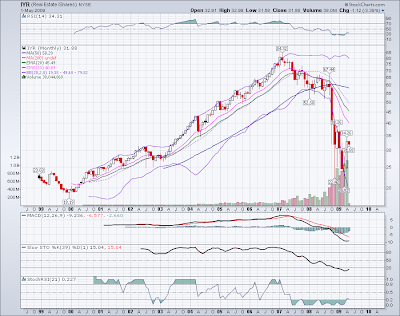Wouldn't you know it, now there's an announcement like this: Etrade Releases Bond Fund Selector Tool (Stock Trading To Go, 3/30/09). Maybe that's a great idea, for those among you who aren't afraid to buy bonds in this environment. It concerns me, the idea of buying a bond fund in a period when rates may be rising - you're buying when rates are already quite low, so your interest won't be great, and the bond fund can easily lose principal as bond prices weaken?? Maybe there are some instances where corporate bonds would be good, but why not select them on an individual company basis? From a fundamental perspective, I find it challenging to get excited about any bonds. The deflationary cycle indicates that credit gets tighter, and the rates one may be charged for credit cards, taking out loans, etc. may be higher, but the rates one may be paid on bonds might not necessarily spike up until the cycle turns the corner toward inflation again. Unless there are individual cases where a company is willing to pay a good rate and there's good creditworthiness ... but, aren't there better investments?
I noticed an article, Ben Bernanke – Bond Market Bozo… talking about the effect of interest rates on real estate. I already posted a while ago (you can find using the "Real Estate" label) my views that housing and real estate peaked out, and whenever a mild rally may be finished, there are new lows to explore. That will be the case from an Elliott Wave standpoint if I'm right, that the recent bubble was a 5th-wave peak after a triangle. Note also that Martin Armstrong has stated that his Economic Confidence Model's February 2007 peak corresponded well to real estate - you can see that with the chart of the ETF for real estate, IYR (below). Given that his model indicates continued down into 2011, wouldn't it be prudent for us to think that real estate may not bottom until then?
Yesterday I found another chart, this one of home prices going back futher, to the 1940's (sorry, I do not know the source - not indicated). It looks more exaggerated because it doesn't seem to be a constant-dollar chart, so inflation (dollar weakening) obviously helped these home prices in California and New York fly up dramatically since the 1980's. If the dollar continues to strengthen, that alone would keep pressure on these prices. But actual deflation is also likely to strengthen - a double whammy that may have us considering ourselves lucky if home prices stabilize where they were back in the 1970's.
The IYR charts are also below. I included a weekly view on which I've added some basic technical analysis markings for trendlines and Fibonacci levels (bottom chart). The indicators on the weekly and monthly charts are consistent with the recent movements up being a counter-trend rally. If I had to place Elliott Wave counts onto it, I'd be tempted to mark it as being in some part of a fourth-wave correction. I don't have a particular view just when IYR would move lower, along with real estate. It's pretty evident that there's resistance at the possible channel trendlines I marked, along with moving averages and Bollinger Band midlines. For reference, the 200-day moving average is about 39.36, but it doesn't "have to get there" given these other resistance levels it's already encountering on the weekly chart.







No comments:
Post a Comment